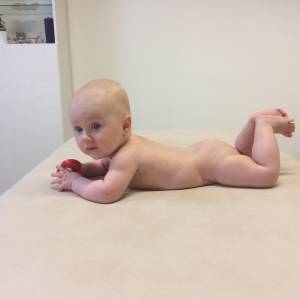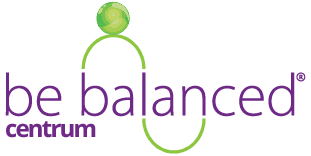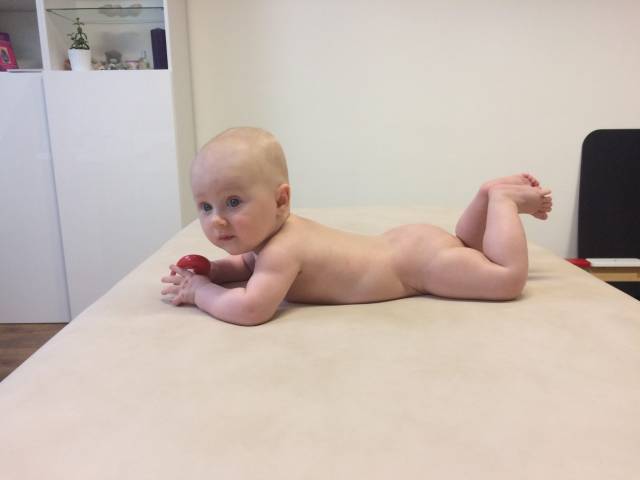Physiological development of babies – First Year
 The first months of life are key, from the aspect of motor development. It may seem very early, but knowing the typical motor milestones and when approximately they should occur is extremely important in the diagnosis and treatment of developmental disturbances.
The first months of life are key, from the aspect of motor development. It may seem very early, but knowing the typical motor milestones and when approximately they should occur is extremely important in the diagnosis and treatment of developmental disturbances.
Ideally, it’s best to capture a delay in development, or a non-physiological development as early as possible, before any substitute patterns are created by the newborn and then fixed into their movement repertoire. From the 6th week of life, a baby is already able to develop compensatory mechanisms therefore the earlier the treatment the better, as we can still highly influence the maturing brain and reinforce the ideal patterns.
Here, we will describe a child’s physical development, in terms of quality, during the first year of life, so that you may deduce how your child moves and recognize any ‘weak’ links in their development, especially for example after a difficult birth, or for babies with higher risk for developmental delays. Moreover, if you have any doubts or questions, please do not hesitate to contact us, we would be glad to help.
1st month of life
When babies are born and leave the mother’s womb, they struggle with a lot of changes and stresses from the new environment. They have to deal with the influence of gravity, begin to breathe by themselves, manage their temperature, eat food via the mouth and cope with digestion and excretion. Although they are able to see, just a short distance, they’re unable to observe who and what is around them. They’re also bombarded with other sensory inputs; auditory, olfactory, taste and tactile sensations. All this places high demands on the body of the small newborn, which is why they tend to sleep for the majority of the day.
The position of a healthy newborn is asymmetric. They often prefer to look to one side. This is called a physiological predilection. However, they should be able to rotate the head to the opposite side when an adequate stimuli is introduced, for example, if they smell the mother’s breast milk then they’re able to turn their head towards it but normally returns the head to the side of predilection afterwards.
When the newborn lies on their backs, they usually move constantly in a jerky manner and here we may observe the legs and arms kicking and moving alternately. The movements are generalized and non-purposeful. When we lay them on their stomach, their head is turned to one side to breathe and they support themselves on their bent knees and arms placing their head at a position lower than their pelvis.
At the age of 6 weeks
From 4 to 6 weeks, the predilection and jerky movements slowly begin to disappear and even if you lay a child on their stomach, their pelvis should appear to be lower. Eye contact fixation appears in most children, as they begin to observe objects and express a desire to grasp it by turning and lifting their heads up. Their main impulse and motivation to move are mainly their emotional needs. Their attempts to reach for objects may elicit the position of the “fencer” as they turn their head to the side of the stimulus/object of interest, and stretch out their hand in an effort to grasp it (free fists), while the other hand flexes to a bent position.
In the photograph above, the child is in a ‘’fencer’’ type position, however it’s not ideal. Why not? It’s important to distinguish a physiological fencer position from an abnormal one. The hand on the stretched out side in the picture isn’t in a free fist but instead a closed fist, with an inward rotation of the arm, therefore it isn’t prepared for grasping. This means that the child has weakened deep abdominal muscles that are not providing enough stability in the trunk area to allow for good distal movement, and when this is the case we can observe that the belly of the baby is protruding to the sides and their lower ribs point out, as in the photo. These difficulties can be treated successfully by the Vojta method. If left untreated, the baby would continue to develop with weakened deep belly muscles and reach all the motor milestones, however they would just do so by creating inadequate motor patterns and compensations.
On the stomach position, a 6-week-old baby should rest on the forearms and belly, and already be able to raise the head a little bit from the activation of the deep neck muscles, but can’t hold it for long. You would also notice that the pelvis isn’t lifted up high anymore, and the feet are stretched out loosely on the ground. We should change positions of the child at this age frequently. It’s practically important to give the baby sufficient tummy-time, preferably without diapers.
At the age of 8 weeks
During this period, a so-called physiological dystonia is typical. This is when the baby ‘’shakes’’ their hands and feet upon seeing their mother or a toy. Parents are sometimes concerned about such movements and ask whether this is normal, and it is. The desire to reach for an object is also expressed by movement of their whole body and the use of different facial expressions.
On the tummy, a baby at 8 weeks is able to lift the head in a neutral position and keep optical contact while supporting on the forearms and the lowest part of their abdomen. Rotation of the head still isn’t completely isolated and causes a side-bending of the spine. They still have their hands enclosed in fists. On the back, the child should also be able to raise the legs off the bed and hands symmetrically and show contact of the fingers, but more often the legs rest with the heels on the table.
3 months
The age of 3 months is considered one of the most important milestones. A strong foundation is created around this age. The quality of this foundation is responsible for how the baby will hold their posture up until adulthood as well.
At this age, the baby can already take a completely symmetrical position. While lying on the stomach, the body weight is shifted to the pelvic region and elbows, allowing an even extension of the spine and raising of the chest to a higher position with their palms open. They are able to hold a longer eye contact and rotate the head to both sides (30 degrees) and communicate with their surroundings. The baby should be stable on the belly and shouldn’t show tendencies to fall or turn around. If a child turns to his back or belly at this stage, it’s not an expression of their rapid development but on the contrary, a sign of instability. While on the back, there is contact of both hands, palm to palm, and the legs are lifted off the ground with 90 degree flexion at the hips, knees and ankles. A lot of hand-to-mouth play is seen at this age.
If a child has poor development or weakened activation of the deep abdominal muscles, they would spend the majority of the time lying on the back with their feet down, or constantly kicking and doing “bridges”, as compensation. Sometimes, that can also be normal behavior, however it wouldn’t last more than a few weeks. To distinguish a true weak belly, flaring out of the ribs or the abdominal muscles to the sides occurs every time a child would raise their legs.
4-6 months
As we’ve already mentioned previously, during the first 3 months of development, an important foundation is built which is the main support base for all movements of the limbs. This is due to the balanced activation of both the extensors and flexors of the axial organ and the intra-abdominal pressure created within the abdomen. The abdominal pressure is created by the abdominal muscles, the pelvic floor muscles and the diaphragm. The quality of this balanced activation can be seen from the position of the child lying on his back, symmetrically and very stable. If this support base is insufficient or weak, there would be overloading or worsened movements of the limbs and they would eventually wear and tear. Lack of any of these key areas will be reflected in further developments but not necessarily like a delay in development milestones, but rather in the quality of movements being carried out. This can result for example in scoliosis, or other faulty postures such as: flat legs, crooked knees, rounded or flat back, bulging belly, protruded shoulder blades, forward-head posture and so on, which are seemingly small things but may still cause a lot of problems in adulthood like the majority of pain syndromes we see today.
4th-5th month
After a child of this age, we want nothing but a pretty stable position on their back and tummy. A child in four months already searches the sources of sounds with their stronger eyesight. The child is able to change their voice, laugh and usually require more contact and attention and could recognize the faces of their loved ones and build strong relationships with them, specifically the mother. By 4.5 months old, the child should perform all their skills symmetrically on both left and right sides. If you have registered that the child prefers to support or use one side more than the other and that this lasts for over two weeks, it’s recommended to seek medical attention. We may also recognize that the child when anxious to grasp something, creates an airplane position with their limbs and this unstable position is often a sign of weak abdominal muscles and inadequate support of the upper extremities. This may later be connected to problems in crawling.
The most important position when the child is on their stomach is the crossed-pattern support position. This is when the child supports on one elbow and the opposite knee (both limbs in flexion), and grasps at toys with the free arm. Here, the deep core muscles are activated creating a neutral position in the hips. This also allows for rotation and extension of the spine up to the lower back. In the back lying position, the baby begins to reach for toys in mid-line, examine them by manipulation and move them from hand to hand. They also begin to grasp across mid-line, which is the very beginning of turning to the side. The legs are lifted above the floor/bed almost all the time with a higher range of hip flexion that they are able to touch their knees, and their feet have full contact with each other.
By age of 5 months, the child straightens up even higher on the tummy by extending the arms fully and weight bearing on the upper thighs. When handling toys in the midline, they may show a type of ‘swimming’ position but just for a brief moment (not to be confused with airplane position which isn’t ideal), where they extend their legs and arms out before changing their position. The child should also be able to reach for toys that are higher than the shoulder, from the ability to flex the shoulders above 90 degrees (higher development of the shoulder joint). While lying on the back, the turning process begins and it’s important to notice how the rotation is being done. It should not be by the use of the head or excessive movement of the arms and legs but by the body as a whole. If a bad way of turning is seen, it may be a sign that the previous development wasn’t ideal. Also, you may find that your child doesn’t roll often at all, which is then recommended to motivate turning more by the use of toys and helping your baby perform the movement correctly.
6 months
A child at this age can see at an angle of more than 180 degrees, and has better focus and able to see a greater distance. The presence of any asymmetry in the eye movement or sight is a definite reason to visit an ophthalmologist. They begin to also mimic sounds and pronounce their first syllables. With the ability to move the tongue and the jaw to the sides, the baby is able to chew and therefore can start to eat solid foods. If a child is unable to chew by this age, it’s likely that a speech disorder may occur in the future.
In terms of motor development, a child of age 6 months is very similar to 5 months with the important exception in grasping. At 6 months, a child can already reach and grasp for toys using radial grasping. This is when the thumb and index fingers are the main and first contact with the object. They also often chew on what’s grabbed and explore it with the hands and mouth and often also play with their feet (at 7 months, they begin to put their toes into their mouth). Turning to the belly process becomes typical and regular, meaning completed oblique muscle chains activation.
With great motivation, the child is able to get to a 4-point crawling position on the hands and knees. In this position, the baby just swings forward and backwards without actually crawling and bears most of the weight on the knees. Any attempts to move the hands forward would normally cause them to fall back onto their stomach.
7 months and up
The next important milestones develop around 7 months and above, which is getting into the sitting position without any assistance. After that, the “verticalization” development begins, to get the child up to independent standing. Getting to crawling from lying and sitting positions becomes more repetitive and also just before crawling they may ‘creep’ for a while, using the same movements as in crawling but with the belly lowered to the ground. Eventually, the child will learn how to pull themselves up to standing using furniture or support and make a few unstable steps with a support. After 13 months, they are finally able to walk, sit and stand alone and enjoy carrying objects whilst doing so as well. Even once they reach this final milestone, do not expect that the child will not develop any problems, for at 2 or 3 years of age, movement difficulties can appear and be worse than in the first year of life.
An important note to end with is to remember that the child doesn’t have to develop according to a strict developmental chart. The maturation of the brain however always takes place under the same principles and same patterns, so it’s necessary for a child to pass through certain phases in a certain order, because the steps before are always necessary for the next higher level, like building blocks. We may not be concerned about some delays, however if they are delayed for a long period of time, over 3 weeks, or there is asymmetry or compensatory patterns present in their movement behavior then those are always indicative of therapy.
What we offer
We offer, in both English and in Czech, classes for mothers and their children on the physiological development of children from ages 0 up to 14 months.
Read more about our classes or register for them at following links:

